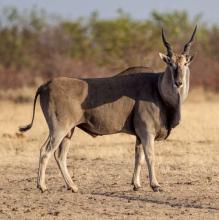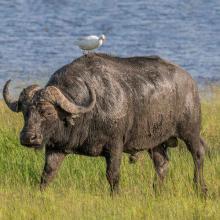Bison bonasus
Common name:
European bison
Genus:
Bison
Family:
Bovidae
Suborder:
-n/a-
Hippotragus niger
Common name:
Giant sable antelope
Genus:
Hippotragus
Family:
Bovidae
Suborder:
-n/a-
Taurotragus oryx
Common name:
Southern eland
Genus:
Taurotragus
Family:
Bovidae
Suborder:
-n/a-
Aepyceros melampus
Common name:
Impala
Genus:
Aepyceros
Family:
Bovidae
Suborder:
-n/a-
Tragelaphus spekii
Common name:
Sitatunga
Genus:
Tragelaphus
Family:
Bovidae
Suborder:
-n/a-
Oryx gazella
Common name:
Gemsbok
Genus:
Oryx
Family:
Bovidae
Suborder:
-n/a-
Syncerus caffer
Common name:
African buffalo
Genus:
Syncerus
Family:
Bovidae
Suborder:
-n/a-
Antidorcas marsupialis
Common name:
Springbok
Genus:
Antidorcas
Family:
Bovidae
Suborder:
-n/a-
Connochaetes taurinus
Common name:
Blue wildebeest
Genus:
Connochaetes
Family:
Bovidae
Suborder:
-n/a-
Alcelaphus buselaphus caama
Common name:
Red hartebeest
Genus:
Alcelaphus
Family:
Bovidae
Suborder:
-n/a-
Kobus ellipsiprymnus
Common name:
Ellipsen waterbuck
Genus:
Kobus
Family:
Bovidae
Suborder:
-n/a-
Tragelaphus strepsiceros
Common name:
Greater kudu
Genus:
Tragelaphus
Family:
Bovidae
Suborder:
-n/a-
Bison bonasus
Common name:
European bison
Genus:
Bison
Family:
Bovidae
Suborder:
-n/a-
Hippotragus niger
Common name:
Giant sable antelope
Genus:
Hippotragus
Family:
Bovidae
Suborder:
-n/a-
Taurotragus oryx
Common name:
Southern eland
Genus:
Taurotragus
Family:
Bovidae
Suborder:
-n/a-
Aepyceros melampus
Common name:
Impala
Genus:
Aepyceros
Family:
Bovidae
Suborder:
-n/a-
Tragelaphus spekii
Common name:
Sitatunga
Genus:
Tragelaphus
Family:
Bovidae
Suborder:
-n/a-
Oryx gazella
Common name:
Gemsbok
Genus:
Oryx
Family:
Bovidae
Suborder:
-n/a-
Syncerus caffer
Common name:
African buffalo
Genus:
Syncerus
Family:
Bovidae
Suborder:
-n/a-
Antidorcas marsupialis
Common name:
Springbok
Genus:
Antidorcas
Family:
Bovidae
Suborder:
-n/a-
Connochaetes taurinus
Common name:
Blue wildebeest
Genus:
Connochaetes
Family:
Bovidae
Suborder:
-n/a-
Alcelaphus buselaphus caama
Common name:
Red hartebeest
Genus:
Alcelaphus
Family:
Bovidae
Suborder:
-n/a-
Kobus ellipsiprymnus
Common name:
Ellipsen waterbuck
Genus:
Kobus
Family:
Bovidae
Suborder:
-n/a-
Tragelaphus strepsiceros
Common name:
Greater kudu
Genus:
Tragelaphus
Family:
Bovidae
Suborder:
-n/a-
Bison bonasus
Common name:
European bison
Genus:
Bison
Family:
Bovidae
Suborder:
-n/a-
Hippotragus niger
Common name:
Giant sable antelope
Genus:
Hippotragus
Family:
Bovidae
Suborder:
-n/a-
Taurotragus oryx
Common name:
Southern eland
Genus:
Taurotragus
Family:
Bovidae
Suborder:
-n/a-
Aepyceros melampus
Common name:
Impala
Genus:
Aepyceros
Family:
Bovidae
Suborder:
-n/a-
Tragelaphus spekii
Common name:
Sitatunga
Genus:
Tragelaphus
Family:
Bovidae
Suborder:
-n/a-
Oryx gazella
Common name:
Gemsbok
Genus:
Oryx
Family:
Bovidae
Suborder:
-n/a-
Syncerus caffer
Common name:
African buffalo
Genus:
Syncerus
Family:
Bovidae
Suborder:
-n/a-
Antidorcas marsupialis
Common name:
Springbok
Genus:
Antidorcas
Family:
Bovidae
Suborder:
-n/a-
Connochaetes taurinus
Common name:
Blue wildebeest
Genus:
Connochaetes
Family:
Bovidae
Suborder:
-n/a-
Alcelaphus buselaphus caama
Common name:
Red hartebeest
Genus:
Alcelaphus
Family:
Bovidae
Suborder:
-n/a-
Kobus ellipsiprymnus
Common name:
Ellipsen waterbuck
Genus:
Kobus
Family:
Bovidae
Suborder:
-n/a-
Tragelaphus strepsiceros
Common name:
Greater kudu
Genus:
Tragelaphus
Family:
Bovidae
Suborder:
-n/a-
Family (Animalia): Bovidae
The Bovidae comprise the biological family of cloven-hoofed, ruminant mammals that includes cattle, bison, buffalo, antelopes, and goat-antelopes. A member of this family is called a bovid. With 143 extant species and 300 known extinct species, the family Bovidae consists of eight major subfamilies apart from the disputed Peleinae and Pantholopinae. The family evolved 20 million years ago, in the early Miocene.
The bovids show great variation in size and pelage colouration. Excepting some domesticated forms, all male bovids have two or more horns, and in many species, females possess horns, too. The size and shape of the horns vary greatly, but the basic structure is always one or more pairs of simple bony protrusions without branches, often having a spiral, twisted or fluted form, each covered in a permanent sheath of keratin. Most bovids bear 30 to 32 teeth.
Most bovids are diurnal. Social activity and feeding usually peak during dawn and dusk. Bovids typically rest before dawn, during midday, and after dark. They have various methods of social organisation and social behavior, which are classified into solitary and gregarious behavior. Bovids use different forms of vocal, olfactory, and tangible communication. Most species alternately feed and ruminate throughout the day. While small bovids forage in dense and closed habitat, larger species feed on high-fiber vegetation in open grasslands. Most bovids are polygynous. Mature bovids mate at least once a year and smaller species may even mate twice. In some species, neonate bovids remain hidden for a week to two months, regularly nursed by their mothers; in other species, neonates are followers, accompanying their dams, rather than tending to remain hidden.
The greatest diversities of bovids occur in Africa. The maximum concentration of species is in the savannas of eastern Africa. Other bovid species also occur in Europe, Asia, and North America. Bovidae includes three of the five domesticated mammals whose use has spread outside their original ranges, namely cattle, sheep, and goats. Dairy products such as milk, butter, and cheese are manufactured largely from domestic cattle. Bovids are also raised for their leather, meat, and wool.
Reference: Wikipedia












